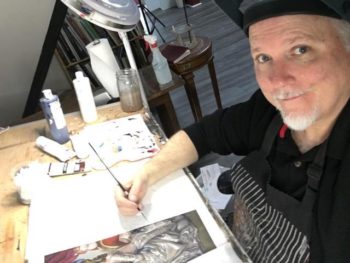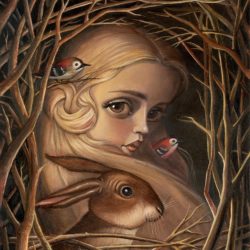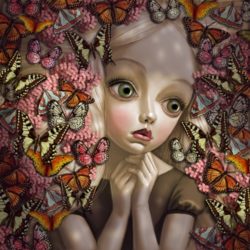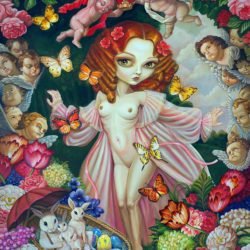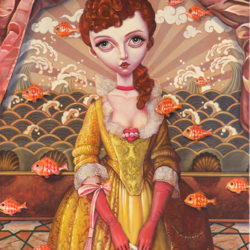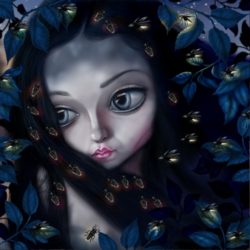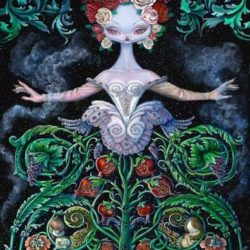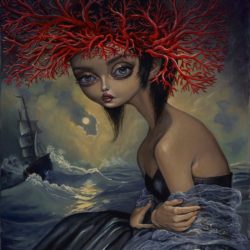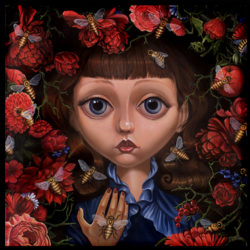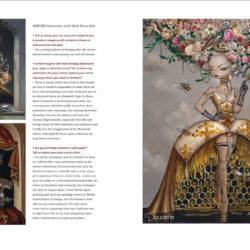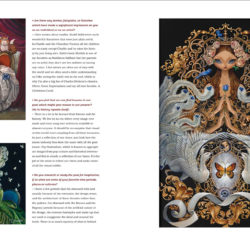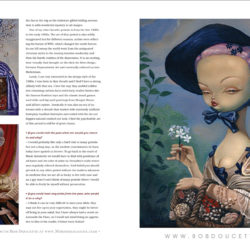Q: Tell us about your art and what inspired you to produce imagery with a historic theme or elements from the past.
A: I’m a strong believer in keeping alive the conversation between contemporary art and art history.__________
Q: Is there anyone who has strongly influenced your style or direction in art? Or is there any artist from the past which inspires your art in any way whom you wish to mention?
A: There so many artists from history that inspire me that it would be impossible to name them all but a few outstanding one’s that really give my art its historical flavor are Élisabeth Vigée Le Brun, Marie Antoinette’s personal portrait artist, her contemporary Adélaïde Labille-Guiard for their portraiture and costuming, the amazing Surrealist Remedios Varo for her whimsy and soul, the German Expressionist, especially Otto Dix and George Grosz for their distortion and darkness and I really love the exaggeration of the Mannerist artists, especially El Greco, quite evident in my long limbs and necks.
Q: Are you formally trained or self-taught? Tell us about your path as an artist.
A: For all the art lessons and art schools I’ve been to I still feel like I was self-trained artist as few classes offered any real instruction but just the freedom to discover. I feel like that is a lot of people’s experience from art school today, unless you go to an atelier or a real commercial school like Art Center in Pasadena that is heavily into technique you have to wing it alone. I loved all my figure painting and museum painting courses at Rhode Island School of Design, but the teachers never offered any real techniques. The only demo I ever had in a painting class that I still use was, at eight years old, in my first oil painting class when I learned how to wash my brushes.
Q: Tell us a little about your preferred medium and technique, do you have any favorite products or applications?
A: I love art supplies in general! I was too poor in art school to afford enough supplies to get all my work done so it is a blessing to be able to afford to go to a store like Blick’s and just indulge myself with supplies. I paint in acrylics and oils and sometimes a combination of the two. I will shamelessly promote my favorite brushes which I order from Trekell and are all made in America and are fantastic, I am also beholding to Gamblin for my oil paint and their mediums. I especially like using Gamsol Odorless Mineral Spirits for cleaning brushes, Gamvar Gloss for varnishing and Gamblin Gel Medium in tubes to mix with my paint. I typically start with grisaille and add color slowly but I’m not rigid about it and tend to experiment with different methods for every painting.
Q: Are there any stories, fairytales, or histories which have made a significant impression on you as an individual or as an artist?
A: I love stories about misfits. Roald Dahl wrote such wonderful characters that were just plain awful. In Charlie and the Chocolate Factory all the children are so nasty except Charlie and he wins the factory by being just being nice. Dahl’s book Matilda is one of my favorites as Matilda is brilliant but her parents are so awful they don’t see her abilities as having any value. I feel artists are often out of step with the world and we often need a little understanding so I like seeing the misfit win in the end which is why I’m also a big fan of Charles Dickens’s classics, Oliver, Great Expectations and my all time favorite A Christmas Carol.
Q: Do you feel that we can find lessons in our past which might give reason to our present? (As in history repeats itself).
A: There is a lot to be learned from history and Art history. We live in an era where every image ever made and every song ever written is available to almost everyone. It should be no surprise that visual artists would start sampling from all these treasures, it’s just a reflection of our times, just look how the music industry has done the same with all the past music. Pop Surrealism, which is known to appropriate images from pop culture and historical references and this is clearly a reflection of our times. It’s the job of the artist to reflect our times and make sense of all the visual rubble.
Q: Do you research or study the past for inspiration, if so what are some of your favorite time periods, places or cultures?
A: I have a few periods that I’m obsessed with and usually because of the costumes, the design sense, and the architecture of those decades rather than the politics. I’m obsessed with the Rococo and the Regency periods because of the artificial nature of the design, the extreme hairstyles and make-up that are used to exaggerate the ideal and conceal the truth. There is so much mystery of what is behind the fan or the wig or the elaborate gilded folding screens that it adds wonderful mystery to all images.
One of my other favorite periods is from the late 1920s to the early 1930s. The art of that period is also wildly exaggerated but for different reasons, artists were reflecting the horror of WWI which change the world forever. In one fell swoop, the world went from the antiquated Victorian styles to the roaring twenties modernity and then the harsh realities of the depression. It is an exciting time visually that brought us the slick Art Deco design, German Expressionist Art and eventually ushered us into Modernism.
Lastly, I am very interested in the design style of the 1960s. I was born in that decade and I find I have a strong affinity with that era. I love the way they molded rubber into charming cartoon faces with furry stuffed bodies like the famous Rushton toys and the classic board games, mod dolls and big-eyed paintings from Margret Keene and all her copiers. Ironically it was also an era of extremes with a decade that started with extremely artificial hairspray bouffant hairstyles and ended with the far-out hippie’s natural combed outlook. I find the psychedelic art of this period to still be of great charm.
Q: If you could visit the past what era would you return to and why?
A: I would probably like only a a brief visit to many periods but not a long stay, as the modern conveniences we have today have spoiled us forever. To go back to the court of Marie Antoinette we would have to deal with the pestilence of all kinds and the odor of urine on Versailles’s walls where men regularly relieved themselves. God forbid you should get sick in any other period without the modern advances in medicine that we are all so lucky to live with now and as a gay man I can’t think of many periods where I would be able to freely be myself without persecution.
Q: What do you feel is the artist’s role in society, for example, as an artist, do you feel that you have an obligation to bring awareness to certain issues which might have a greater impact visually than a verbal account might have? Or do you feel that art is non-political? Is its sole purpose to inspire, or be decorative, or is the hope to get a reaction?
A: I believe that art can be all these things or none of them and we should be careful as artists to not impinge on the rights of other artists in the judging how they want to express themselves. My personal vision for my art is about making connections. Making connections with the great artists and cultures that have come before me. To connect with my contemporaries and honor what they are doing now in my life time and mostly I want to connect to an audience and bring them succor when they need it by pouring all my love into what I create.
Q: If you could meet any artist from the past who would it be a why?
A: I think it can be very difficult to meet your idols, they may not live up to your expectation, they might be better off living in your mind, but I have always had a crush on Leonardo Da Vinci so I would not mind being an apprentice to him in his studio. I better learn Italian!
Q: What advice do you have for artists just starting out?
A: Listen to everyone’s advice and then throw it all away. The things you need to know, you will find inside yourself and don’t be afraid to be yourself, it is the only original thing you have to offer the world.
Q: If you had full funding for any project, what would it be?
A: To be rid of the concern for having to sell or having to make money for a full year so that I had freedom to express myself fully as I please would be amazing! I dream of being able to spend my days painting large paintings and sculpting bronzes that will end up in a big beautiful Museum show.
Q: If you were to attribute any emotional, spiritual, or physical context to your art, what would it be? Is there a story behind the image, a feeling, a dream or belief?
A: My art is always a reflection of my mental state. I’m either commenting on how I see the world and its inhabitants with all their foibles or I’m exploring my spiritual growth in the world from within. I often have an avatar that is a stand-in for me and my attitudes toward things. I love symbols and metaphors but I prefer the ones that are not forced but come up freely from the subconscious through dreams or inspired thoughts. I live as a visual person and therefore always lead with the visual and leave the cognitive work to the conceptual artists. Some critics believe that art cannot have craft and must exist conceptually first and foremost but I highly disagree with this sentiment and despise the concept that bad drawing is good art. Modern art has been around for 100 hundred years and maybe the critics want to keep it alive but the artists must kill their darlings and make way for the new to truly be contemporary.



